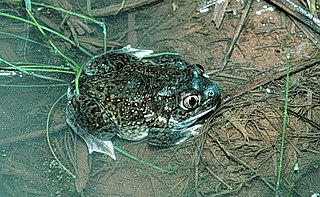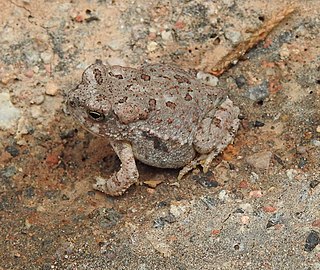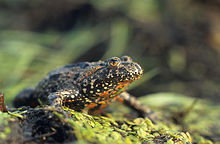
Bufo is a genus of true toads in the amphibian family Bufonidae. As traditionally defined, it was a wastebasket genus containing a large number of toads from much of the world but following taxonomic reviews most of these have been moved to other genera, leaving only seventeen extant species from Europe, northern Africa and Asia in this genus, including the well-known common toad. Some of the genera that contain species formerly placed in Bufo are Anaxyrus, Bufotes, Duttaphrynus, Epidalea and Rhinella.

The common toad, European toad, or in Anglophone parts of Europe, simply the toad, is a frog found throughout most of Europe, in the western part of North Asia, and in a small portion of Northwest Africa. It is one of a group of closely related animals that are descended from a common ancestral line of toads and which form a species complex. The toad is an inconspicuous animal as it usually lies hidden during the day. It becomes active at dusk and spends the night hunting for the invertebrates on which it feeds. It moves with a slow, ungainly walk or short jumps, and has greyish-brown skin covered with wart-like lumps.

The Scaphiopodidae are a family of American spadefoot toads, which are native to North America. The family is small, comprising only seven different species.

The American toad is a common species of toad found throughout Canada and the eastern United States. It is divided into three subspecies: the eastern American toad, the dwarf American toad and the rare Hudson Bay toad. Recent taxonomic treatments place this species in the genus Anaxyrus instead of Bufo.

A true toad is any member of the family Bufonidae, in the order Anura. This is the only family of anurans in which all members are known as toads, although some may be called frogs. The bufonids now comprise more than 35 genera, Bufo being the best known.
Werneria, also known as the torrent toads or smalltongue toads, is a small genus of "true toads", family Bufonidae. They are found in western Central Africa, with the greatest species richness in the Western High Plateau of Cameroon. The species generally have restricted or patchy distributions and are considered threatened.

Scaphiopus is a genus of North American amphibian commonly referred to as the North American spadefoots, southern spadefoots, or eastern spadefoot toads. They differ greatly from true toads by having eyes with vertical pupils, no parotoid gland, and relatively smooth skin. Their most distinctive feature is a spade-like projection on their hind feet, from which their common name is derived. This projection enables spadefoot toads to dig in loose soils with ease. Its scientific name means ‘spade-foot’ as well, from the Ancient Greek skaphís and pous.

Spea is a genus of North American amphibian commonly referred to as the western spadefoot toads. They differ greatly from true toads by having eyes with vertical pupils, no parotoid glands, and relatively smooth skin. Their most distinctive feature is a spade-like projection on their hind feet, from which their common name is derived. This projection enables spadefoot toads to dig in loose soils with ease. Its name is from the Ancient Greek speos

The plains spadefoot toad is a species of American spadefoot toad which ranges from southwestern Canada, throughout the Great Plains of the western United States, and into northern Mexico. Like other species of spadefoot toads, they get their name from a spade-like projection on their hind legs which allows them to dig into sandy soils. Their name, in part, comes from their keratinized metatarsals, which are wide instead of "sickle shaped". The species name translates as buzzing leaf shaped. This refers to the species' distinguishing features; its buzzing mating call, and its leaf-shaped digging metatarsals. It was first described by Cope in 1863.

The parotoid gland is an external skin gland on the back, neck, and shoulder of some frogs, and salamanders. It can secrete a number of milky alkaloid substances known collectively as bufotoxins, which act as neurotoxins to deter predation. These cutaneous glands are called parotoid as they are somewhat similarly positioned to mammalian parotid gland, although the latter have a different function, excreting saliva within the mouth rather than externally excreted defensive chemicals.
Bufoides kempi is a species of true toad, family Bufonidae. This poorly known species is endemic to Meghalaya, Northeast India. It is only known with certainty from its type series collected "above Tura" at 2,500 ft (760 m) in the Garo Hills no later than 1919; there is also a possible record collected at around 2009. Its common names are Kemp's Asian tree toad, Garo Hills toad, and Garo Hills tree toad. The specific name kempi honours Stanley Wells Kemp, an English zoologist and anthropologist.

Sclerophrys garmani, also known as Garman's toad or eastern olive toad, is a species of toad in the family Bufonidae. It is widely distributed in East and Southern Africa. However, populations north and south of Tanzania might represent distinct species. If so, the name Sclerophrys garmani would apply to populations from northeastern Africa. Furthermore, its southern boundary towards the range of Sclerophrys poweri in South Africa is also unclear.
Poyntonophrynus hoeschi is a species of toad in the family Bufonidae. It is endemic to western and central Namibia. The specific name hoeschi honours Walter Hoesch, a German zoologist. Common names Hoesch's toad, Hoesch's pygmy toad, and Okahandja toad have been proposed for it.

Rhinella icterica is a species of toad in the family Bufonidae that is found in northeastern Argentina, southern Brazil, and eastern Paraguay. "Cururu" is its indigenous name and refers to the male advertisement call that is a melodious tremolo. "Cururu toad", without the specifier "yellow", is a common name used for a few other closely related species.

Rhinella jimi is a species of toads in the family Bufonidae. It is endemic to northeastern Brazil and known between Bujaru in northeastern Pará and Maranhão in the north, south to Bahia and Vitória, Espírito Santo. Prior to its description in 2002, it was confused with Rhinella schneideri. The specific name jimi honors Jorge Jim, a Brazilian herpetologist. Common name Jimi's toad has been coined for it.

The Arizona toad is a species of toad in the family Bufonidae. It is endemic to the south-western United States, where its natural habitats are temperate lowland forests, rivers and streams, swamps, freshwater marshes, freshwater springs, ponds, open excavations, irrigated land, and seasonally flooded agricultural land.

The raucous toad, also known as Ranger's toad, is a species of toad from Southern Africa.
Sclerophrys tuberosa is a species of toad in the family Bufonidae. It is found in southeastern Nigeria, Cameroon, southwestern Central African Republic, Equatorial Guinea, Gabon, and northern Democratic Republic of the Congo and Republic of the Congo. Common names rough toad, warty toad, and Fernando Po toad have been proposed for it.

Rentapia everetti, also known as Everett's Asian tree toad or marbled tree toad, is a species of toad in the family Bufonidae. It is endemic to Borneo and occurs in both Malaysia, Brunei, and Indonesia.
Ingerophrynus gollum is a toad species in the family Bufonidae, the true toads. It is endemic to the Peninsular Malaysia and has only been recorded from its type locality in the Endau-Rompin National Park, Johor. However, I. gollum is genetically so close to Ingerophrynus divergens that its validity as a distinct species can be questioned.
















